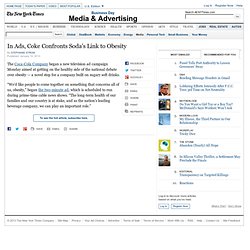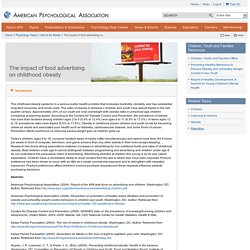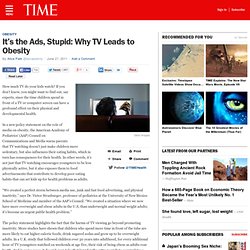

Coke TV Ads Confront Obesity and Soda’s Role. “We’d like people to come together on something that concerns all of us, obesity,” began the two-minute ad, which is scheduled to run during prime-time cable news shows.

“The long-term health of our families and our country is at stake, and as the nation’s leading beverage company, we can play an important role.” The ad goes on to promote steps Coke has taken, like putting calorie counts on “the front” of its cans and other packaging and increasing the number of its brands sold in smaller cans, to help consumers make healthier choices. “There’s a really important conversation going on out there about obesity, and we want to be a part of it because our consumer is telling us they want us to be a part of it,” said Stuart Kronauge, general manager for sparkling beverages at Coca-Cola North America. The ads establish a link between the company and its products and obesity, which could be risky.
“This is not about changing the products but about confusing the public,” said Michele R. Ms. Dr. The impact of food advertising on childhood obesity. The childhood obesity epidemic is a serious public health problem that increases morbidity, mortality, and has substantial long term economic and social costs.

The rates of obesity in America’s children and youth have almost tripled in the last quarter century. Approximately 20% of our youth are now overweight with obesity rates in preschool age children increasing at alarming speed. According to the Centers for Disease Control and Prevention, the prevalence of obesity has more than doubled among children ages 2 to 5 (5.0% to 12.4%) and ages 6 to 11 (6.5% to 17.0%). In teens ages 12 to 19, prevalence rates have tripled (5.0% to 17.6%). Obesity in childhood places children and youth at risk for becoming obese as adults and associated poor health such as diabetes, cardiovascular disease, and some forms of cancer. Sources: American Psychological Association (2004). American Psychological Association (2009).
Centers for Disease Control and Prevention (2006). Koplan, J. Physical health: The media link to obesity, risky diets - Health & Nutrition. Media immersion absolutely affects our kids' physical health.

It contributes to obesity, eating disorders, attention deficit disorders, addictive behaviors and declining levels of fitness. Children, Adolescents, Obesity, and the Media. It's the Ads: Why TV Leads to Obesity - - TIME Healthland. How much TV do your kids watch?

If you don’t know, you might want to find out, say experts, since the time children spend in front of a TV or computer screen can have a profound effect on their physical and developmental health. In a new policy statement on the role of media on obesity, the American Academy of Pediatrics’ (AAP) Council on Communications and Media warns parents that TV watching doesn’t just make children more sedentary, but also influences their eating habits, which in turn has consequences for their health. In other words, it’s not just that TV watching encourages youngsters to be less physically active, but it also exposes them to food advertisements that contribute to develop poor eating habits that can set kids up for health problems as adults.
“We created a perfect storm between media use, junk and fast food advertising, and physical inactivity,” says Dr. The policy statement highlights the fact that the harms of TV viewing go beyond promoting inactivity.